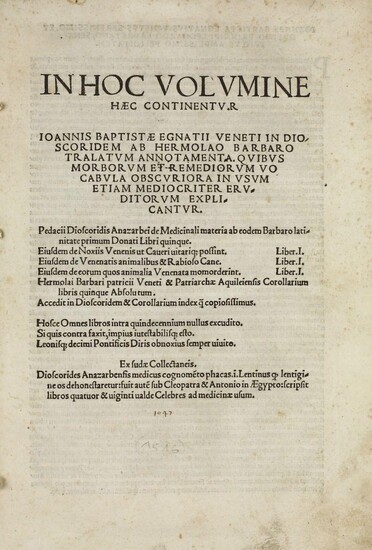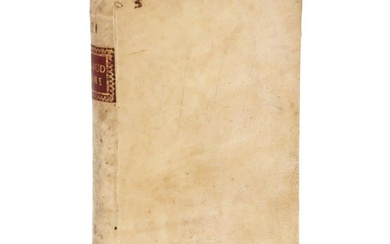In hoc volumine haec continentu.r Ioannis Baptistae Egnatii Veneti In Dioscoridem ab Hermolao Barbaro tralatum annotamenta, quibus morborum et remediorum vocabula obscuriora . : explicantur. / Hermolai Barbari . Corollarii libri quinque non ante...
By DIOSCORIDES, Pedanius
1 Feb. 1516. 2 parts in one volume. Folio (305 x 215 mm). [36], CXXXIII (i.e. CXXXIV); 106 leaves. Signatures: AA6 [cross]8 ([cross]a-[cross]b)8 [cross]c6 (A-X)6 Y8; (A-C)8 D6 (E-M)8 (N-O)6. 16th century limb vellum, spine titled in manuscript (soiling, spotting and light creasing of covers, closing bands gone). Text very fresh and clean with very minor occasional spotting or browning, final gatherings with faint dampstain at fore margin, manuscript note on second title. An exceptionally crisp and wide-margined copy. ---- NLM/Durling 1140; Greene, Landmarks of Botanical History pp. 553-568; Pritzel 2301; Wellcome I 1794. Bird 669; Wellcome I, 1794. FIRST EDITION by Johannes Baptista Egnatius and the definitive one of Ermolao Barbaro's (1454-1493) Latin translation. De medicinali materia, first printed in Latin in 1479 by Petro Paduano was the fons et origo of botanical knowledge until the early seventeenth century: as Sprengel states, "during more than sixteen centuries [Dioscorides] was looked up to as the sole authority, so that everything botanical began with him. Every one who undertook the study of botany, or the identification of medicines swore by his words. Even as late as the beginning of the seventeenth century both the academic and the private study of botany may almost be said to have begun and ended with the text of Dioscorides" (Greene, Landmarks of Botanical History, p.219). The second part is Barbaro's own Corollarii, and is an extended commentary on the plants discussed by Dioscorides with a preface by G.B. Egnazio, printed here for the first time: "Barbaro begins to tell things before untold about familiar plants that have been too succinctly written of during fifteen or twenty centuries; a kind of innovation in botany which was of profound import, and one with which Ruel, Valerius Cordus, Tragus, and Conrad Gesner, of a generation later, have been accredited as first pioneers" (Greene). - Visit our website for additional images and information.
Published by: Gregoriis Brothers for Aloisius and Franciscus Barbari, and Johannes Bartholomeus Astensis, Venice, 1516
Vendor: Milestones of Science Books
Buy Now on
By DIOSCORIDES, Pedanius
1 Feb. 1516. 2 parts in one volume. Folio (305 x 215 mm). [36], CXXXIII (i.e. CXXXIV); 106 leaves. Signatures: AA6 [cross]8 ([cross]a-[cross]b)8 [cross]c6 (A-X)6 Y8; (A-C)8 D6 (E-M)8 (N-O)6. 16th century limb vellum, spine titled in manuscript (soiling, spotting and light creasing of covers, closing bands gone). Text very fresh and clean with very minor occasional spotting or browning, final gatherings with faint dampstain at fore margin, manuscript note on second title. An exceptionally crisp and wide-margined copy. ---- NLM/Durling 1140; Greene, Landmarks of Botanical History pp. 553-568; Pritzel 2301; Wellcome I 1794. Bird 669; Wellcome I, 1794. FIRST EDITION by Johannes Baptista Egnatius and the definitive one of Ermolao Barbaro's (1454-1493) Latin translation. De medicinali materia, first printed in Latin in 1479 by Petro Paduano was the fons et origo of botanical knowledge until the early seventeenth century: as Sprengel states, "during more than sixteen centuries [Dioscorides] was looked up to as the sole authority, so that everything botanical began with him. Every one who undertook the study of botany, or the identification of medicines swore by his words. Even as late as the beginning of the seventeenth century both the academic and the private study of botany may almost be said to have begun and ended with the text of Dioscorides" (Greene, Landmarks of Botanical History, p.219). The second part is Barbaro's own Corollarii, and is an extended commentary on the plants discussed by Dioscorides with a preface by G.B. Egnazio, printed here for the first time: "Barbaro begins to tell things before untold about familiar plants that have been too succinctly written of during fifteen or twenty centuries; a kind of innovation in botany which was of profound import, and one with which Ruel, Valerius Cordus, Tragus, and Conrad Gesner, of a generation later, have been accredited as first pioneers" (Greene). - Visit our website for additional images and information.
Published by: Gregoriis Brothers for Aloisius and Franciscus Barbari, and Johannes Bartholomeus Astensis, Venice, 1516
Vendor: Milestones of Science Books




